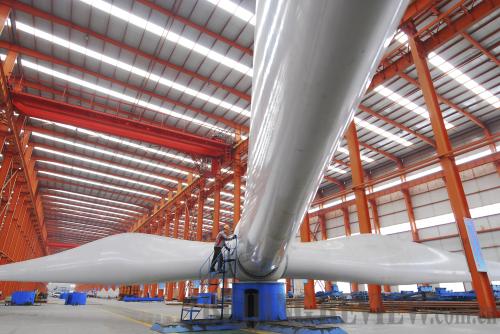|
 |
|
ALTERNATIVE POWER: Workers are assembling wind turbine blades in a workshop of Changxing Wind Power Technology Co. Ltd. in Zouping, Shandong Province. They are producing 700 units of wind tubines for a wind power generation station in Inner Mongolia by the end of this year (XINHUA) |
A Manufacturing Behemoth
China overtook Japan as the world's second largest manufacturing base by the end of 2009, second now only to the United States.
The country made up 15.6 percent of the total output value of global manufacturing industries, compared with the United States' 19 percent and Japan's 15.4 percent, according to Wang Zhongyu, President of the China Enterprises Council.
But most Chinese manufacturers are still focused on low-end products with less added value and have little presence in service businesses, said Wang. Service companies account for 58 percent of all U.S. manufacturers, far above 2.2 percent of China.
Cross-Straits Cooperation
Experts from the Chinese mainland and Taiwan started the second round of talks in Taipei on March 31 for an economic pact aimed to boost cross-Straits economic ties. The first round of expert talks was held in January.
The two-day meeting is expected to speed up the consultation process of the Economic Cooperation Framework Agreement (ECFA), which is intended to normalize mainland-Taiwan economic cooperation.
The two sides exchanged views on the content of the agreement and consultation arrangements in the future, and prepared for formal ECFA discussions to take place in the first half of 2010.
Retailing Rebound
China's top 100 retailers reported an average sales growth of 24 percent during the first two months of the year, indicating the market had rebounded to pre-crisis levels, the Ministry of Industry and Information Technology said.
Jewelry, garment and household appliances recorded around 30 percent sales growth because of the Spring Festival shopping spree, and sales of cosmetics and daily necessities showed lesser increases of 17 percent and 20.2 percent respectively.
In February alone, sales soared by 79.4 percent from a year earlier and food sales skyrocketed by 91.1 percent.
True Money Machines
China's domestically listed companies' profitability improved during 2009, their annual financial reports show.
The 996 companies traded on the China's Shanghai and Shenzhen stock exchanges reported a 19.21 percent increase in total net profits last year, despite their revenues dropping by 1.38 percent year on year, said a China Securities Journal report.
Of those, more than 70 percent posted year-on-year gains in net profits.
The Industrial and Commercial Bank of China, the world's largest bank by market value, remained the country's most profitable company during the year, generating 129 billion yuan ($18.9 billion) in after-tax profits.
Huawei Profit Doubles
Huawei, China's largest telecommunications solutions provider, said on March 31 its net profit in 2009 reached 18.3 billion yuan ($2.68 billion), more than double the previous year.
Its revenue increased 19 percent year on year to 149.1 billion yuan ($21.8 billion), said Huawei in its annual financial report.
The company's steady growth was a result of a client-oriented innovation strategy, said Huawei's Chief Sales and Services Officer Hu Houkun.
It expects a further 20 percent growth in sales this year, given growths in businesses such as the convergence of fixed and wireless telecommunications networks and smart devices such as handsets and video terminals.
Huawei now serves 45 of the top global 50 telecommunications operators, up from 36 in 2008, Hu said. | 